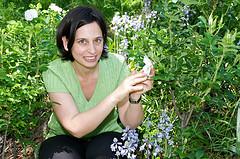
Professor Yael Wyner gets secondary school student to grasp complex ecological concepts by highlighting what happens when things go wrong.
Lessons Learned When Things Go Wrong Connect Ecology to Daily Life
As a middle school science teacher at Hunter High School,Yael Wyner wanted to integrate conservation biology, which is typically taught in college, into the environmental science curriculum. One of the drawbacks, she discovered, was that “students learned about ecology and human impact separately and couldn’t connect the two.”
That connection is critical, she explained, because “for students to be able to make informed decisions on environmental issues, they need to be able to understand the ecology. You can’t have informed citizens without that understanding.”
At Hunter, she developed an approach to show her students how complex ecological processes, such as food webs, could be disrupted by human activity, and she applied real data to show that impact. Now an assistant professor of secondary science education at The City College of New York (CCNY), she and collaborators from the American Museum of Natural History (AMNH) are refining and testing those methods, supported by a three-year National Science Foundation grant.
“We want students to develop better scientific understanding of ecological processes. By looking at how human activity affects ecology and how the ecology responds we can foster that understanding,” says Professor Wyner. Additionally, she hopes that bringing conservation biology into secondary schools will encourage students to pursue careers and live lifestyles that reduce the negative impact of human activity.
Professor Wyner’s approach, called Ecology Disrupted, shows how important and complex ecological processes can go wrong as a result of human activity. It transforms two major themes of conservation biology, biodiversity and ecological integrity, into ecology and environmental topics, which are themes of secondary school environmental science classes.
Through two case studies, it uses environmental issues to connect ecological principles to daily life. The first, drawing upon published research, shows how a highway through the Sierra Nevada Mountains blocks the movement of bighorn sheep and led to inbreeding. The second, based on a study in Baltimore, MD, illustrates how salting of roadways during winter storms results in freshwater streams becoming progressively saltier, which poses a threat to the area’s water supply.
While the data are drawn from scientific research, the findings are presented using video materials created for general audiences by AMNH. These provide context and make the information more accessible to students. “Students explore the background on an issue first, then they look at the data the scientists use,” Professor Wyner explained.
To date, Ecology Disrupted has been tested with 30 teachers at public middle schools and high schools throughout New York City. An additional 60 teachers are currently testing the program in connection with the ninth grade Living Environment course.
Preliminary feedback from teachers indicates that they like the program, in particular the use of data, and that many students experience “aha” moments. New testing to measure the program’s effectiveness will explore how well students connect human impact on ecological processes with daily life as well as student understanding of the importance of evidence and data.
MEDIA CONTACT
Ellis Simon
p: 212.650.6460
e:
esimon@ccny.cuny.edu